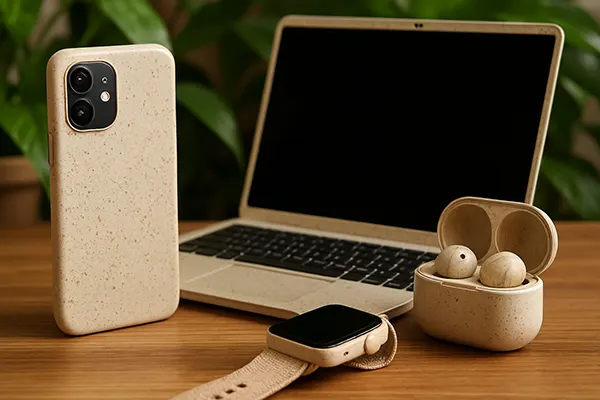In 2025, the tech industry has made a significant shift towards sustainability, with a growing number of devices designed using recycled and environmentally friendly materials. From smartphones and laptops to headphones and wearable gadgets, companies are embracing green tech not only as a trend but as a responsibility. This article explores the latest innovations in sustainable gadgets and highlights the efforts that leading manufacturers are making to reduce their ecological footprint.
Eco-Friendly Smartphones: Innovation Meets Responsibility
Smartphone manufacturers have taken notable steps in 2025 to incorporate recycled materials in both hardware and packaging. For instance, the Fairphone 5 has emerged as a flagship model in ethical design, using 70% recycled plastics and fair-trade gold. Additionally, Samsung’s Galaxy S25 series now uses discarded fishing nets and ocean plastics in its outer casing, offering durability and sustainability.
Apple has also intensified its environmental commitment. The iPhone 16 now includes a 100% recycled aluminium chassis, and rare earth elements in the magnets are sourced from certified recycling programmes. Moreover, Apple’s packaging is entirely plastic-free, aligning with its pledge to become carbon neutral across all product lines by 2030.
These developments show a clear industry trend: sustainability is becoming a core design principle, not an afterthought. This transformation is driven by regulatory pressure, consumer demand, and corporate climate goals, resulting in products that are both eco-conscious and high-performing.
Repairability and Longevity in 2025 Models
One of the key changes in green smartphones is the growing emphasis on repairability. Devices like the Fairphone 5 come with modular components, allowing users to easily replace batteries, cameras, or screens without specialised tools. This reduces electronic waste and extends the lifecycle of the device.
Major brands are also joining the movement. Google’s Pixel 9 is now designed with repair-friendly screws and publishes DIY repair guides, empowering users to perform basic maintenance. Meanwhile, Apple’s Self Service Repair programme has expanded across Europe, giving users access to tools and genuine parts for supported models.
Improved longevity and upgradability contribute directly to environmental protection, as fewer devices are discarded prematurely. By making phones that last longer and are easier to fix, manufacturers can dramatically reduce the carbon emissions associated with constant production.
Laptops and Tablets: Greener Builds and Smarter Efficiency
Laptop and tablet producers are also stepping up in 2025, focusing on both physical materials and energy efficiency. HP’s Dragonfly G5, for example, features a chassis made from 90% recycled magnesium and plastics, while also being EPEAT Gold certified. Its energy-efficient display and battery systems further minimise environmental impact.
Similarly, Microsoft has launched the Surface Pro X Eco Edition, which incorporates upcycled carbon fibre and a keyboard cover made from reclaimed ocean plastics. The product packaging is 100% recyclable and designed to be reused for shipping returns or accessories.
These devices are not just sustainable in their build but also operate on more energy-efficient processors, reducing power consumption without sacrificing performance. The integration of green tech into core architecture ensures long-term benefits for both users and the planet.
Certifications and Industry Standards
Certifications like Energy Star, EPEAT, and TCO Certified have become standard benchmarks for evaluating eco-conscious devices. In 2025, more laptops and tablets than ever before carry multiple certifications, offering users transparent data on sustainability metrics.
Brands are also disclosing their carbon emissions and lifecycle analyses. Dell, for instance, includes detailed environmental impact data in its online product descriptions, helping customers make informed decisions based on ecological performance.
This shift in transparency fosters competition among manufacturers to meet higher standards and encourages ongoing innovation in green manufacturing processes. As consumer awareness grows, certifications serve as a trusted signal of authenticity and commitment.

Wearables and Accessories: Small Devices, Big Impact
Even small devices like smartwatches and wireless earbuds are embracing sustainability. In 2025, Fitbit’s Charge 6 is produced with a case made of 80% recycled stainless steel and a strap fashioned from recycled polyester fibres. Its energy-efficient OLED screen reduces power draw significantly.
Sony’s LinkBuds S have also set a benchmark, using recycled resin from car parts in their casing. Despite the sustainable materials, they maintain high audio quality and noise-cancellation features, proving that eco-design doesn’t compromise functionality.
Charging cables, cases, and other accessories are following suit, with companies like Anker and Belkin offering compostable or fully recyclable products. Even wireless chargers are being developed using bamboo and other biodegradable elements.
Consumer Demand Driving Sustainable Choices
Today’s tech consumers are more environmentally conscious than ever. A growing portion of buyers specifically seek out products that align with their values. As a result, brands that invest in sustainable design are gaining market share and customer loyalty.
Social media and review platforms play a crucial role, allowing users to promote eco-friendly products and hold companies accountable for their practices. Influencers and tech reviewers increasingly highlight green credentials as part of their recommendations.
Ultimately, the demand for sustainability is influencing how products are designed, marketed, and evaluated. The shift towards green tech is no longer optional—it’s a defining characteristic of success in the modern gadget industry.



